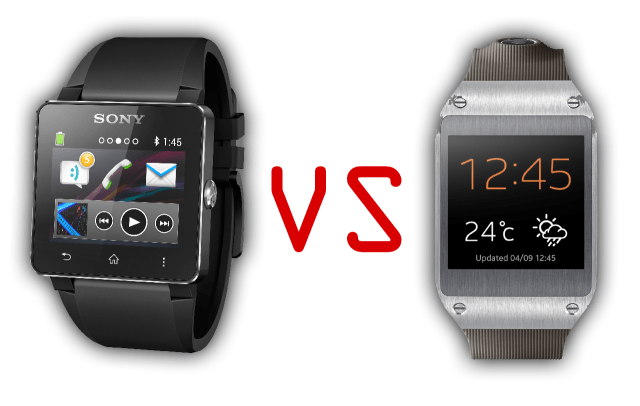Sony’s new smartwatch, which is actually named the SmartWatch 2, has
been a known quantity since its official announcement in June at the
Mobile Asia Expo in Shanghai, and now the Samsung Galaxy Gear has been itemized by its creators in Berlin at IFA. Meaning it’s time for the two to square off in our blogger arena of champions for a spec and feature showdown.

Sony Smartwatch specs
- 1.6-inch, 220×176 display
- Aluminum body
- Micro USB charging
- Compatible with most Android phones
- NFC and Bluetooth 3.0 for connectivity
- 3 to 4 days battery under normal use
- €199 ($262 U.S), Ships in late September
- No camera, mic or speakers
Samsung Galaxy Gear specs
- 1.63-inch, 320×320 display
- Stainless steel body
- Snap-on, proprietary USB 3.0 charger
- 800MHz Exynos single-core processor
- Bluetooth 4.0 LE
- Compatible with new Galaxy devices, previous gen Galaxy support coming soon
- Around 1 day of use
- 4GB of onboard storage
- $299
- Ships in September (October for U.S.)
- 1.9 megapixel camera, 720p video recording, speaker + 2 mics
- Gyroscope and accelerometer for workout tracking
The SmartWatch 2 isn’t cheap at €199; in fact, it’s the same price as
the newly-reduced 8GB Nexus 4 model. Samsung’s is $299 and much more
full-featured, with Samsung managing to pack a whole host of A/V
equipment in its device. It also runs a number of Android apps out of
the box, which have been redesigned specifically for the watch.
SmartWatch 2 does have NFC for easy pairing with Android devices that
support it, as well as more battery life, a better, higher resolution
screen, and water/environment resistance that should keep your device
protected from general grit and submersion at 3 feet for up to 30
minutes. Sony’s also doing a big push for bringing third-party apps to
the SmartWatch software platform, which could help narrow the gap there.
Overall though, as you can see from the list of specs above, there’s
not really much of a competition between the two devices in terms of
features; but Sony’s SmartWatch 2 has an edge in battery life owing to
its much more narrow feature set, and it offers wider support for other
Android devices out of the box.
These are two very different definitions of the term “smartwatch,”
with the more ambitious vision coming from Samsung. Aside from the steep
requirement of apparent (temporary?) platform lock-in, I’m definitely
much more intrigued by the Gear, but I also suspect both devices will
find a mostly limited receptive audience among consumers.






